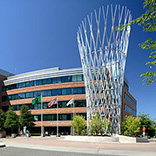Researchers at Fred Hutchinson Cancer Center have developed a new hybridoma cell line that expresses mouse anti-human NKG2D antibodies.
Reference:
- Bauer, et al., Science. 1999; 285(5428):727-9. “Activation of NK Cells and T Cells by NKG2D, a Receptor for Stress-Inducible MICA”

NKG2D is the receptor for MICA. (A) Identification of NKG2D as a candidate sequence by cDNA RDA. Lanes show the Dpn II restriction enzyme representation (cDNA REP) and the sequential representational difference products (RDP1–RDP3). The NKG2D Dpn II cDNA fragment is of 430 base pairs. (B) A full-length NKG2D cDNA was used as a probe in blot hybridization of total RNAs from the NKL, HPB-ALL, Hut 78, and Jurkat cell lines, from a Vδ1 γδ T cell line, and from CD4+ and CD8+ αβ T cells purified from PBLs. Presence or absence of the NKG2D mRNA of ∼1.8 kb correlated with surface binding of bio-sMICA and mAbs 1D11 and 5C6. The larger transcript of ∼3.5 kb presumably was a transcriptional variant of NKG2D. Jurkat-NKG2D transfectants (last lane) have a shorter transcript because of their transfection with a coding region construct. Bottom of panel shows RNA sample loadings. (C) Immunoprecipitation of NKG2D with mAb 5C6 or 1D11 from 125I-surface-labeled cell lines and from Ba/F3 cell transfectants expressing a transmembrane mutant of NKG2D in the absence of DAP10. The protein with a molecular mass of 42 kD corresponds to NKG2D. (D) Flow cytometry showed binding of mAb 1D11 to the Jurkat-NKG2D transfectants but not to the untransfected cells. Binding was increased by coexpression of DAP10.
Available Licenses
To license this product, please complete, sign and return the license agreement to bds@fredhutch.org. Further instructions are provided therein.
Please Note: Academic and non-profit users may license the material for free. Fees for for-profit users are listed in the license agreements. All recipients must pay a fee for material preparation and shipping expenses.
Download license agreement
Commerical Use | Non-commerical Use
Credit line for acknowledgement
When publishing on the use of this material, please provide credit to Dr. Thomas Spies according to accepted publications standards.
Questions About this Product?
